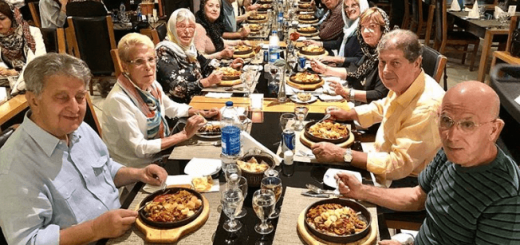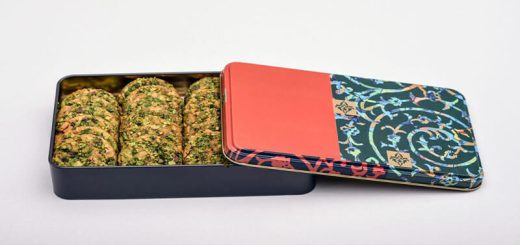Iranian Saffron
by Admin · August 30, 2020
Iranian Saffron
Iranian saffron is the best saffron in the world and Iran is one of the pioneer exporters of this product.
In this blog, we provide all the information about Iranian saffron, including types, prices, and uses. We also explain how to recognize good quality saffron, where to buy it, and how to take it out of Iran.
So please stay with us and if you have any questions on Iranian saffron or if you want to buy saffron from Iran, feel free to contact us.
10 Interesting Things that You Did not Know about Iranian Saffron
- Saffron is taken from the stigmas of the Crocus flower.
- The most expensive spice in the world is saffron, also known as the red gold of Iran.
- 95% of the world’s saffron comes from Iran.
- The best Iran saffron is cultivated in Khorasan’s arid lands in the northeast of the country, with an area of about England’s size.
- From every 150,000 to 200,000 saffron flowers, about 1 kilogram dried saffron is obtained.
- The process of saffron harvesting and detaching the stigmas is complicated and fulfilled with hand.
- Iran saffron harvesting season starts on November 1st and lasts at most three weeks.
- Every year, many tourists from all over the world come to Iran saffron farms during the harvesting season.
- Some countries pack the Iran saffron and sell it under their name, much more expensive.
- Although Persian saffron has numerous therapeutic properties, consuming more than 5 grams of it in one meal can cause human death.
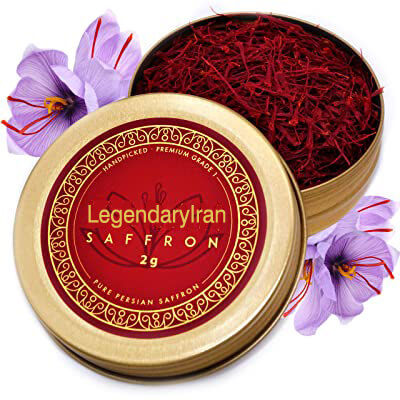
What is Saffron?
Saffron Crocus or Crocus Sativus is a plant with a stem at the end of which is a purple flower with six petals and three red stigmas. The saffron spice comes from the red stigmas of this flower and is known as the red gold spice. Notably, this is the world’s most precious spice due to its complicated harvesting process.
What is Saffron Used for?
Saffron is a special seasoning and a favorite spice in Persian cuisine; Because it gives a beautiful color and pleasant aroma to Persian food and sweets. Accordingly, Iranians use it in rice, kebabs, stews, desserts, ice cream, and even tea. Besides, saffron plays a vital role in Shole Zard, a Persian rice pudding served in ritual ceremonies.
On the other hand, the Iranian use saffron in dying the handmade Persian rugs.
- Saffron Benefits
Interestingly, saffron is very nutritious and good for health. Accordingly, saffron therapeutic properties include reducing blood pressure, preventing heart disease, decreasing cholesterol, and improving mood and energy. Also, as it is full of antioxidants, it helps to prevent cancer. Besides, it is helpful in the treatment of the stomach and abdomen.
However, in addition to its numerous therapeutic properties, excessive use of saffron causes poisoning. So that consuming more than 5 grams of saffron in one meal can cause human death.
"Which country has the best saffron? Iran's Due to Iran's diverse climate and fertile soil, the country's agricultural products are rated among the best in the world, with its saffron standing second to none. Saffron is a spice derived from the flower of the saffron crocus."
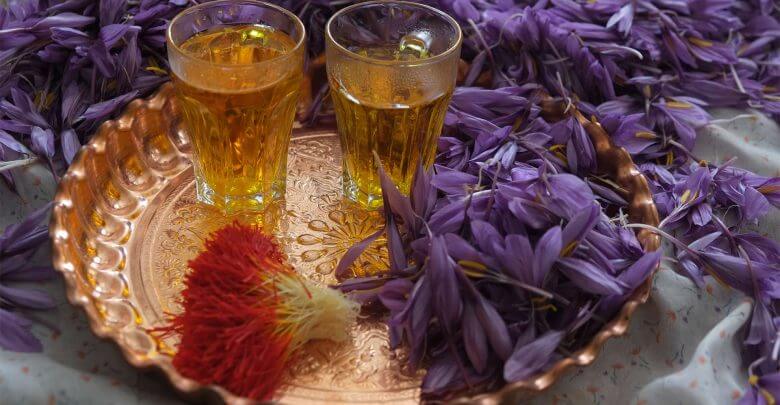
Iranian Saffron Harvest Season
Saffron does not grow in lush areas with pleasant weather; it grows in arid lands where there is a significant temperature difference between night and day. So the climate of Razavi Khorasan and South Khorasan provinces in Iran is very suitable for this crop.
In Iran, the saffron harvest season is short and starts from about November 1st and lasts for almost three weeks. When the purple flowers of saffron cover the farms in the eastern regions of the country and Fars province, the saffron harvest time starts. The farmers head to the farms before sunrise when the saffron flower has still not opened up. They begin picking the flowers by hand very fast and carefully until a short time after sunrise. Then they transfer the flowers to a cool and clean roofed place to separate the stigmas from the flowers. Notably, they carry out the process of taking out the stigmas by hand; they take out all the stigmas carefully and let them dry.
Now we can answer the question “Why is Persian saffron so expensive?”. Because the saffron harvesting process is difficult and for every 150,000 to 200,000 saffron flowers, about 1 kilogram of dried saffron is obtained. This makes saffron the most expensive spice in the whole world.
Iran Saffron Harvest Festival
Every year during saffron harvest season in Iran, the saffron festival is held around the country.
The process of Persian saffron harvesting and separating stigmas is done during the festival. It is so exciting and entertaining that attracts many tourists from all over the world to Iran’s saffron farms during November. You can also be a part of this process and help the farmers in saffron harvesting.
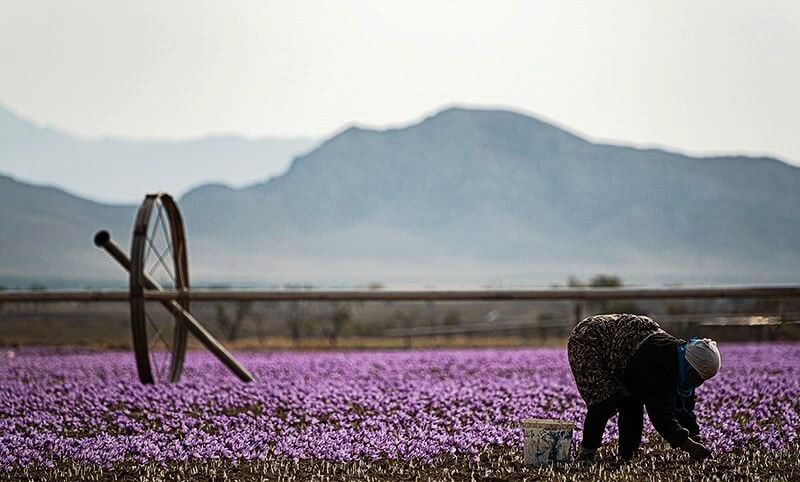
Where to Buy Saffron in Iran
More than 300 tons of Persian saffron is harvested every year, and Iran accounts for about 95% of the world’s saffron production and most of its amount is exported. So, Iran is the biggest producer and exporter of saffron in the world.
In short, Iran saffron is currently exported to 40 countries, including the UAE, Spain, China, India, Hong Kong, Italy, and more. Interestingly, some countries pack the Iran saffron and sell it under their name, much more expensive.
Hence, if you want to buy top-quality saffron, Iran is the best place to buy it and it is considered the best Iran souvenir.
Now, the critical question is where to buy saffron in Iran. Accordingly, the primary market of saffron in Iran is Mashhad, which obtains its saffron product from farms in Qaen, Torbat Heydariyeh, Gonabad, Khaf, and Taybad. Saffron is also planted in the Fars Province, but its quality is lower than Khorasan saffron. After all, the best saffron of Iran is Qaenat saffron which comes from Qaen region.
In addition to Mashhad, you can buy Persian saffron in Tehran, Shiraz, Isfahan, Yazd, and other Iran cities, or you can order it online. To buy Iranian saffron, or get more information about saffron, please contact us.
"How can I get saffron from Iran? you can find most of Persian Saffron selling shops around 17 Shahrivar Square in Mashhad. But in other cities like Shiraz, Isfahan, Yazd and Tehran you can easily buy Saffron as well. Bear in mind that you cannot take more than 100 grams of Saffron out of Iran per passport."
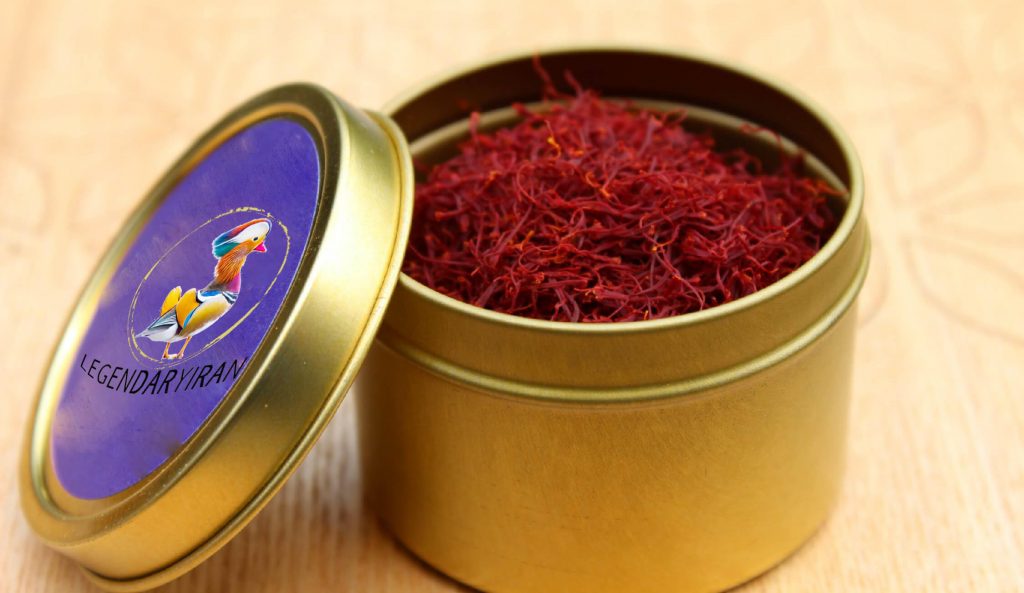
How to Identify Original Saffron from the Fake One
As saffron is expensive, there is also fake saffron in Bazaar. Here we explain how to spot the fake saffron:
1) First, you need to identify the appearance of saffron. The saffron stigmas are trumpet-shaped at the top and become narrower at the bottom, and their color is bright red.
2) One of the main methods to identify real saffron from a fake one is to recognize the saffron taste. Real and high-quality saffron always has a sweet smell, not a sweet taste. Sometimes profiteers dip saffron in honey or sugar to increase its weight. So, if you put saffron on your tongue and feel the sweet taste in your mouth, this is a fake one. After all, the original saffron is slightly bitter or sometimes does not have any particular taste.
3) Another definitive method for identifying the original saffron is its aroma. So, you must know the smell of authentic saffron well. This aroma is a combination of the scents of honey and alfalfa. In short, the fresher the saffron is, the sharper its smell is.
4) Another way to distinguish real saffron from a fake one is by its color. To do this, pour a little saffron in warm water, and after a short time, the color of the saffron reveals. Now, take the stigmas of saffron out of the water; if the saffron is original, the stigmas’ primary color has not changed much. But in fake saffron, after removing them from the water, you see that the color of the stigmas is wholly lost.
Besides, the original saffron has a slower coloring speed, so if the color saffron reveals quickly, it is fake.
On the other hand, the color of the original saffron in water turns yellowish-orange and light red, and transparent. So, the dark red color in the water indicates that the saffron is fake. Also, saffron stigmas are not shiny. Moreover, the original saffron does not dissolve in gasoline, and if you pour a little of it into gasoline, it should not change its color.
5) Sometimes profiteers have added oil to saffron to increase weight. To diagnose this, pour a little saffron on a piece of paper or press it between your fingers. If grease stains remain on the paper or between your fingers, this saffron is not pure.
6) Another way to determine the authenticity of saffron is to put a little saffron on the stove flame. If its color changes to purple or orange, the saffron is pure. But the fake saffron turns yellow.
"How can you tell real saffron from fake? Appearance – Saffron threads are trumpet-shaped. If a thread does not bulge at one end, it's a fake. If you rub real saffron between your fingers, your skin will turn yellow/orange. Taste – While saffron smells sweet, it tastes slightly bitter, not sweet."
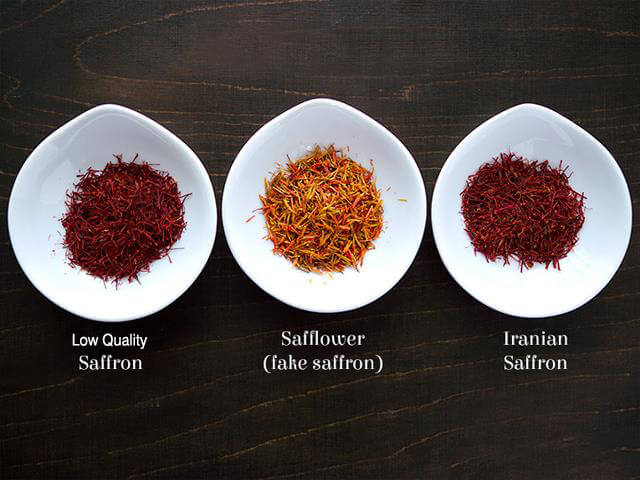
Iranian Saffron Price (Updated Jan 2023)
The most frequent question about Iranian Saffron is “How much is Iranian saffron?”
As mentioned, the price of saffron in Iran is lower than in other countries. Here, we are talking about the Iranian saffron price in Iran.
Saffron is categorized into some types based on its quality that depends on the geographical origin of cultivation, the age of the plant, and some other factors. The best and most expensive Iran Saffron comes from Khorasan Province.
But in any case, when we ask about the Iranian saffron price, the first question that arises is “The price of which type of saffron?”
So, here we introduce different types of Iranian saffron with their approximate prices in Iran.
Please note that due to the fluctuation of dollar prices in Iran, saffron price should be recalculated based on your Iran trip time.
Price of Sargol saffron
Sargol Saffron, which is the red part of the saffron flower stigma is the most expensive part of this plant. Moreover, Sargol is the part of saffron that you can find more than the other types of saffron in Iran markets. If the red part of three stigmas is attached and forms a cluster, it is called Negin saffron.
Currently, the Sargol saffron price in the market of Iran is between 6 to 10 dollars per Mesghal (each Mesghal is equivalent to 4.6875 grams). The reason for this difference in Sargol saffron price is not only because of the brand or packaging; also, it depends on the quality of saffron, including its coloring and aroma.
Besides, there are other types of saffron in the Iranian saffron market called Nagin and Super Nagin saffron.
Negin Saffron is similar to Sargol saffron. However, Nagin saffron threads are elongated and have the least breakage, while most threads of the Sargol type are broken. These two types of saffron are the best Iranian saffron, which do not differ from each other in terms of color, taste, and aroma.
Notably, the Negin Saffron price is more than 10 USD per Mesghal.
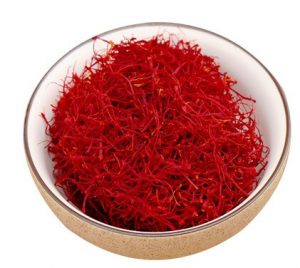
Price of Bunch Saffron
Bunch saffron or Dasteh saffron is the whole stigma, including the yellow and red part of it, which is less expensive than Sargol saffron. Most farmers in the Ghaenat region, which is the primary origin of saffron in Iran, produce Bunch Saffron. Because they know that the yellow part of the saffron stigma has the same properties as the red part, and they see no reason to throw it away. Notably, this kind of saffron is also called Pushal saffron.
There is not a very specific price in the market for Dasteh saffron, but in the Khorasan Province, its price is usually between 4 and 7 dollars per Mesghal. This price difference depends on the difference in their coloring power and packaging.
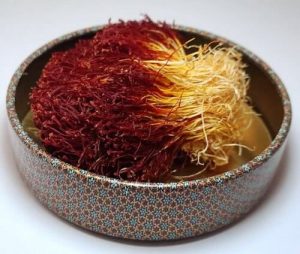
Price of Saffron Root
The saffron root is a part of saffron that you can not find it everywhere. For many, the question is, “what is the benefit of consuming saffron root?”. The answer is if you are looking for the properties of saffron (color and benefits) and you want to spend less, saffron root is a good choice. Usually, the Iranian saffron root costs about 2 dollars per Mesghal.
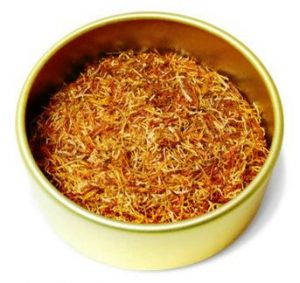
Transportation of Iranian Saffron
Saffron should be away from light and moisture, and it is better to keep it in dark glass or metal containers. Since saffron oil can be evaporated quickly, its medicinal effects and quality will be reduced if stored outdoors. Hence, the box should be in such a way that air does not penetrate it.
Moreover, saffron is a fragile product, so you must be very careful in carrying it. Therefore, the most suitable way to transport this product is by taking it in a rigid metal box.
The Permissible Amount of Iran Saffron with the Passenger
Since saffron is one of the most valuable export products and it is much more expensive in other counties than Iran, there are some restrictions on taking it out from Iran. Accordingly, the maximum amount of saffron allowed to exit is 100 grams per passport. If it is more than this amount, they will either not allow it or charge you a fee as trade profit and customs duty.
The Permissible Amount of Iran Saffron Sent by Post
You can mail up to 100 grams of Iranian saffron to other countries without the customs license. But to send 100 grams to 2 kg of saffron by post, you have to go through a series of customs steps. Please note that in Iran, the high-quality Iranian saffron price per gram is about 2$. However, this price changes due to the quality of the packaging and the dollar rate at the time of buying.
How to Use the Persian Saffron that You Have Bought
After you take saffron to your home, you must keep it in a hard container such as a metal or dark glass container. Put the box in a dark, dry, and cool place and make sure that the air can not penetrate it. Don’t keep saffron in the freezer, because it loses its aroma.
To use saffron in the food, you can follow one of the below methods:
- Grind a few stigmas gently, mix them with a little hot water, and let them brew in a warm place.
- Put a small ice cube on the powdered saffron and let the ice melt.
In both methods, after a few minutes, the beautiful dark orange color of saffron reveals. You can add some of the dissolved saffron to the rice, chicken, meat, or even your tea.
Finally, please ask your questions or share your comments about Iranian saffron. We appreciate your valuable comments, and they will also be useful to others.
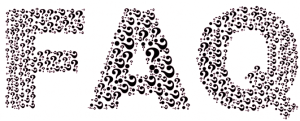
Most Frequent Questions and Answers about Iranian Saffron
Like this article?
Subscribe To Our Newsletter
Get updated articles about Iran trip
Leave a comment

